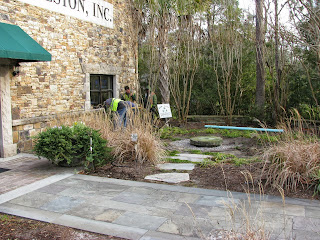I have included a step by step guide in this post on how to put together one of our new products. Manufactured by Mid-Atlantic Concrete products the pictures detail the installation of the Grand Island Bar in front of our office on Johns Island. We had the help of the crew from Superior Surfaces Concrete. The picture above shows the area before construction began.
We began by filling in the void of the existing water feature. The next step was to dig out the space so that we could add base material from our pavers.
Using a laser level we check the grade and started to form the outdoor kitchen area to pour a concrete footer. The Mid-Atlantic Grand Island bar is designed to be installed on at least a 4" concrete footing.
I have never seen an outdoor kitchen come together this quickly.

We squared up the forms with the building and waited for the concrete truck to arrive.
We added additonal 4" PVC pipes to gain access to the middle of the outdoor kitchen for electric and potential plumbing.
After the footer was poured we prepped the rest of the area with an ROC crushed limestone base.
The limestone base was compacted in 4" lifts
Now it is time to start installing the outdoor kitchen
If you have ever played with Legos or lincoln logs as a kid this process should be pretty self explanatory. The Mid-Atlantic system comes with a layer by layer diagram to follow throughout the installation process.
One of the most important things to check as you are building the unit is to make sure everything is square and plumb as you build up.
Once the base layer is set and checked for square the process of stacking moves much more quickly.
All of the custom size pcs in the Mid-Atlantic kit come pre-cut and labeled to match the diagram. There is no need for additional equipment for this job.
The openings come with pre-cut angle iron support.
All of the Mid-Atlantic concrete products kits come with gloves and the masonry adhesive used to put the products together.
The process of installation goes fast with extra hands. Included with the literature for each product you will find a man hour estimation to put each kit together. If you are planing to install these products often this information is extremely helpful to have in your estimating process.
I have never seen an outdoor kitchen come together this quickly.
If you follow the directions correctly the door and grill provided in the kit slide right in.
One of the great features of these kit systems are the unique attention to detail in the design.
Checking to make sure the blocks are correct before sliding in the grill.
This shot is a good example of the specialty cut pieces. You can also see the shims that are provided in the kit.
Almost there.
After putting the provided countertops into place this job is complete.
 "
" 



